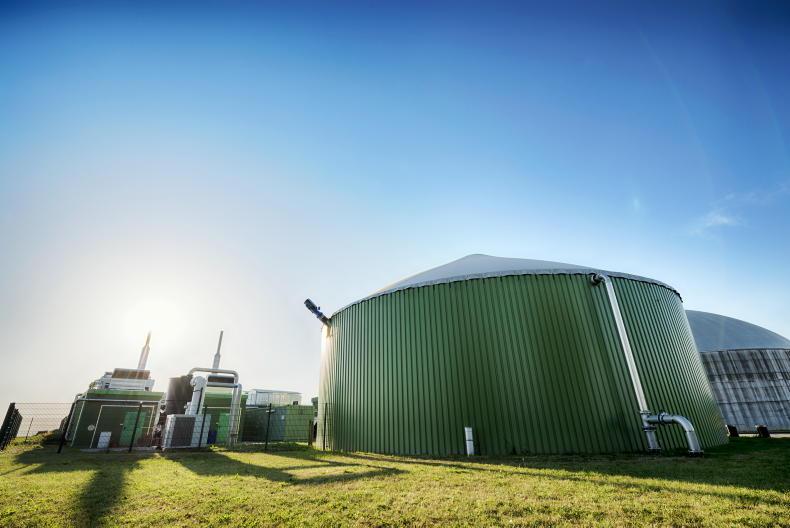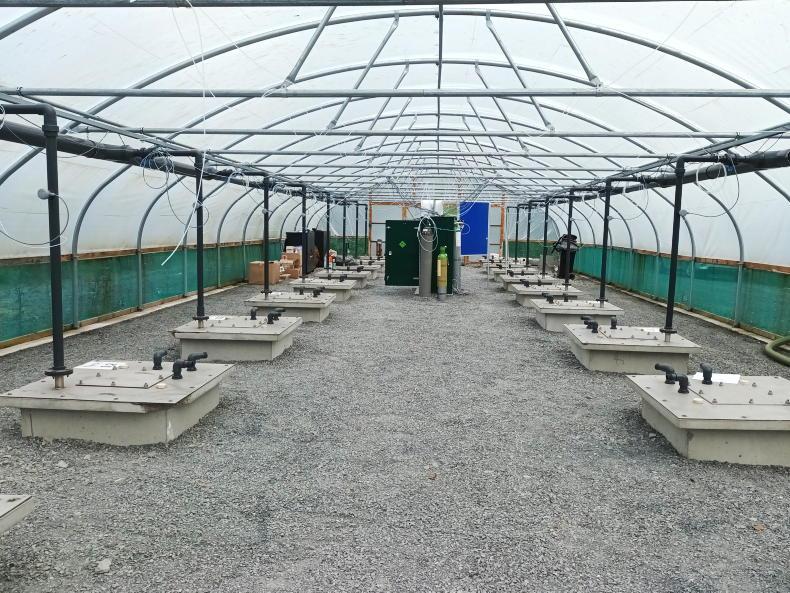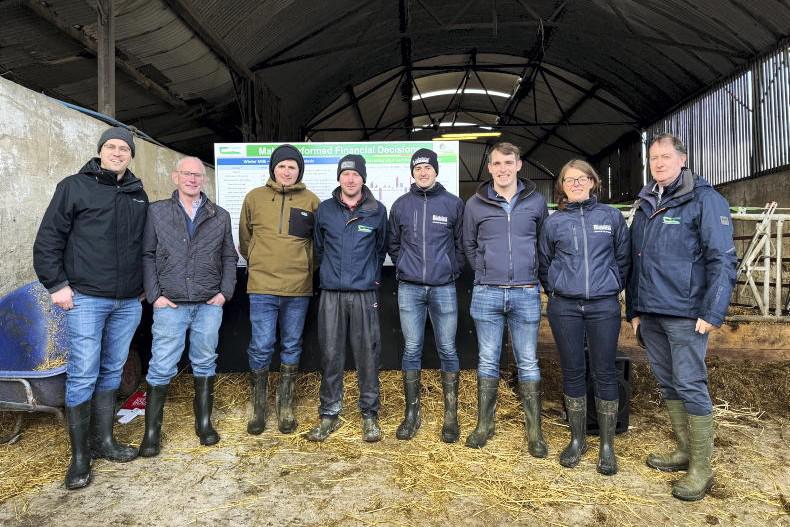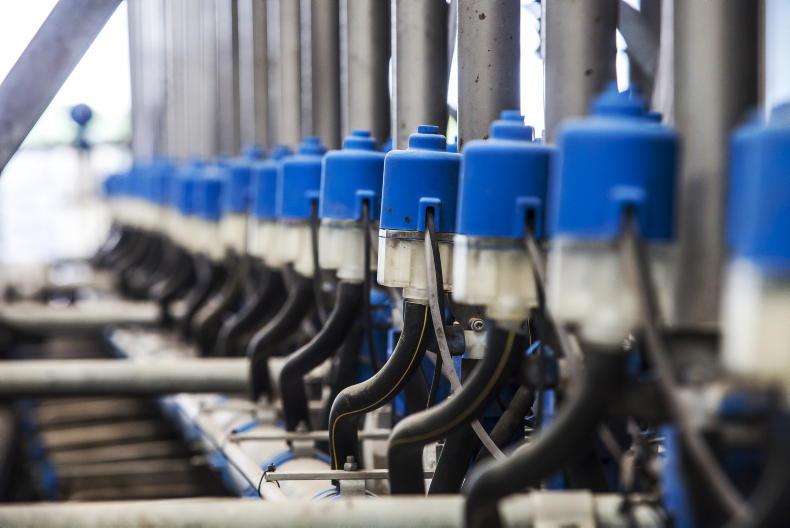Across all sectors, feed and forage production make up around 15% of greenhouse gas emissions from Irish farms.
Given that winter milk herds need a high protein feed source during the winter months when grass is not available, the contribution of feed and forage to the greenhouse gas emissions profile of winter milk herds is greater.
Speaking last month at the Teagasc winter milk open day in Johnstown Castle, Teagasc researcher Michael Dineen said that 71% of all high-protein feeds used in Europe are imported, most usually from North or South America.
In light of initiatives to reduce greenhouse gas footprint of Irish dairy, plus the impact of deforestation of the Amazon alongside the risks associated with price volatility, food security and geopolitical disruptions, Teagasc has been researching the impact of homegrown protein feeds on milk production.
The first trial was conducted over the winters of 2019-20 and 2020-21 with 86 cows in the study with two diets being compared. The make-up of the two diets is outlined in Table 1, the key differences being no forage maize was included in the homegrown diet and no high protein imported feeds such as soya bean meal and maize meal were fed.
Instead, a high protein homegrown concentrate made up of field beans and barley was fed instead.
The trial was conducted across two full lactations and the results are highlighted in Table 2.
The key point is that there is approximately 200kg less milk produced when imported protein is not fed in the diet. There is no difference in fat percentage between the treatments, but protein percentage was lower in the native feeds treatment.
In total, there was a difference of 25kg MS/cow between the two treatments in favour of the imported proteins and, according to Michael Dineen, almost all of this difference in performance occurred during the housing period when animals were not getting access to grass.
According to Michael, the results of the first trial presented researchers with a question; was the performance lower because there was no maize in the diet or because there was no imported protein in the diet? This led to a second experiment being set up in the winter of 2021-22, which looked at the removal of high protein imported feeds but kept the forages the same.
This experiment lasted for eight weeks over the housed period with a six week carryover period. The two diets in the experiment are outlined in Table 3.
There is no difference in grass or maize silage intake between the treatments, but the conventional treatment was fed 7kg of concentrate including imported soya bean meal and maize distillers whereas the homegrown diet included 8.2kg of native feeds, including field beans and rapeseed meal.

Teagasc has been researching the impact of homegrown protein feeds on milk production. \ Donal O'Leary
The results of this study are outlined in Table 4, the key points being that once again milk yield was negatively affected by the removal of imported proteins in the diet.
The cows on the homegrown feed diet produced about 2kg less milk per day or 0.18kg MS/cow less per day compared to those on the imported protein diet.
According to Michael, the carbon footprint of the milk produced by the homegrown diet was 30% lower than that produced from imported protein.
He says the reason for the reduction in milk yield is likely down to lower levels of metabolisable protein and lower levels of amino acids in the homegrown diet.
Future research on the topic is looking at adding rumen protected amino acids to the diet and feed processing technology such as heat treatment of peas and lupins, along with the inclusion of alternative forages such as red clover silage, which is higher in crude protein.
In terms of cost, Michael said that the cost of feed was similar at the time of the experiment but that bean prices are more volatile.
As over 62.5% of agriculture’s greenhouse gas emissions are from methane, there is a big focus on looking at ways to reduce emissions.
Teagasc researcher Ben Lahart said there are four key areas of research:
Investigating the base line of methane emissions. Ben said that recent research has found that actual emissions are 9% lower than previously thought.Looking at animal factors such as genetics, age and EBI.Looking at dietary factors such as seasonality of pasture and its impact on methane emissions and grass quality. The potential of feed additives to reduce methane emissions. In relation to feed additives, Ben outlined that the additive 3-NOP is licensed for use in Ireland and has been found to deliver a 20% to 30% reduction in methane emissions when used in total mixed ration (TMR) systems.
However, only a 5% to 6% reduction has been found in grazing systems.
This is because the cows are getting the 3-NOP in their concentrate feed and as they only get this twice-a-day at milking times, its residual impact is lower.
Ben said that because winter milk herds are generally fed silage or TMR over the winter, there is scope for 3-NOP to be incorporated into the diet of winter milk herds. An experiment was conducted looking at the impact of including 3-NOP in the winter diet of 44 cows, with another 44 cows on a control treatment on the same diet but with no 3-NOP.
Methane emissions decreased by 26% from 447g/day to 330g/day for cows on the additive
The trial was conducted over a seven-week period and the results of the experiment show that where the additive was fed, milk solids yield increased by 2% from 2.45kg MS/cow/day to 2.5kg MS/cow/day.
Methane emissions decreased by 26% from 447g/day to 330g/day for cows on the additive while emission efficiency – that is the amount of methane per kilo of milk solids – also decreased from 182g/kg MS to 132g/kg MS for cows on the additive, a 27% reduction.
According to Ben, the 3-NOP was easy to include in the diet with the required amount mixed with concentrate in the bucket of a loader each morning before being added to the diet feeder and mixed with silage.
He said the results look promising but at a current cost of €80/cow, the economics of feeding the additive are weak at present.
Across all sectors, feed and forage production make up around 15% of greenhouse gas emissions from Irish farms.
Given that winter milk herds need a high protein feed source during the winter months when grass is not available, the contribution of feed and forage to the greenhouse gas emissions profile of winter milk herds is greater.
Speaking last month at the Teagasc winter milk open day in Johnstown Castle, Teagasc researcher Michael Dineen said that 71% of all high-protein feeds used in Europe are imported, most usually from North or South America.
In light of initiatives to reduce greenhouse gas footprint of Irish dairy, plus the impact of deforestation of the Amazon alongside the risks associated with price volatility, food security and geopolitical disruptions, Teagasc has been researching the impact of homegrown protein feeds on milk production.
The first trial was conducted over the winters of 2019-20 and 2020-21 with 86 cows in the study with two diets being compared. The make-up of the two diets is outlined in Table 1, the key differences being no forage maize was included in the homegrown diet and no high protein imported feeds such as soya bean meal and maize meal were fed.
Instead, a high protein homegrown concentrate made up of field beans and barley was fed instead.
The trial was conducted across two full lactations and the results are highlighted in Table 2.
The key point is that there is approximately 200kg less milk produced when imported protein is not fed in the diet. There is no difference in fat percentage between the treatments, but protein percentage was lower in the native feeds treatment.
In total, there was a difference of 25kg MS/cow between the two treatments in favour of the imported proteins and, according to Michael Dineen, almost all of this difference in performance occurred during the housing period when animals were not getting access to grass.
According to Michael, the results of the first trial presented researchers with a question; was the performance lower because there was no maize in the diet or because there was no imported protein in the diet? This led to a second experiment being set up in the winter of 2021-22, which looked at the removal of high protein imported feeds but kept the forages the same.
This experiment lasted for eight weeks over the housed period with a six week carryover period. The two diets in the experiment are outlined in Table 3.
There is no difference in grass or maize silage intake between the treatments, but the conventional treatment was fed 7kg of concentrate including imported soya bean meal and maize distillers whereas the homegrown diet included 8.2kg of native feeds, including field beans and rapeseed meal.

Teagasc has been researching the impact of homegrown protein feeds on milk production. \ Donal O'Leary
The results of this study are outlined in Table 4, the key points being that once again milk yield was negatively affected by the removal of imported proteins in the diet.
The cows on the homegrown feed diet produced about 2kg less milk per day or 0.18kg MS/cow less per day compared to those on the imported protein diet.
According to Michael, the carbon footprint of the milk produced by the homegrown diet was 30% lower than that produced from imported protein.
He says the reason for the reduction in milk yield is likely down to lower levels of metabolisable protein and lower levels of amino acids in the homegrown diet.
Future research on the topic is looking at adding rumen protected amino acids to the diet and feed processing technology such as heat treatment of peas and lupins, along with the inclusion of alternative forages such as red clover silage, which is higher in crude protein.
In terms of cost, Michael said that the cost of feed was similar at the time of the experiment but that bean prices are more volatile.
As over 62.5% of agriculture’s greenhouse gas emissions are from methane, there is a big focus on looking at ways to reduce emissions.
Teagasc researcher Ben Lahart said there are four key areas of research:
Investigating the base line of methane emissions. Ben said that recent research has found that actual emissions are 9% lower than previously thought.Looking at animal factors such as genetics, age and EBI.Looking at dietary factors such as seasonality of pasture and its impact on methane emissions and grass quality. The potential of feed additives to reduce methane emissions. In relation to feed additives, Ben outlined that the additive 3-NOP is licensed for use in Ireland and has been found to deliver a 20% to 30% reduction in methane emissions when used in total mixed ration (TMR) systems.
However, only a 5% to 6% reduction has been found in grazing systems.
This is because the cows are getting the 3-NOP in their concentrate feed and as they only get this twice-a-day at milking times, its residual impact is lower.
Ben said that because winter milk herds are generally fed silage or TMR over the winter, there is scope for 3-NOP to be incorporated into the diet of winter milk herds. An experiment was conducted looking at the impact of including 3-NOP in the winter diet of 44 cows, with another 44 cows on a control treatment on the same diet but with no 3-NOP.
Methane emissions decreased by 26% from 447g/day to 330g/day for cows on the additive
The trial was conducted over a seven-week period and the results of the experiment show that where the additive was fed, milk solids yield increased by 2% from 2.45kg MS/cow/day to 2.5kg MS/cow/day.
Methane emissions decreased by 26% from 447g/day to 330g/day for cows on the additive while emission efficiency – that is the amount of methane per kilo of milk solids – also decreased from 182g/kg MS to 132g/kg MS for cows on the additive, a 27% reduction.
According to Ben, the 3-NOP was easy to include in the diet with the required amount mixed with concentrate in the bucket of a loader each morning before being added to the diet feeder and mixed with silage.
He said the results look promising but at a current cost of €80/cow, the economics of feeding the additive are weak at present.












SHARING OPTIONS